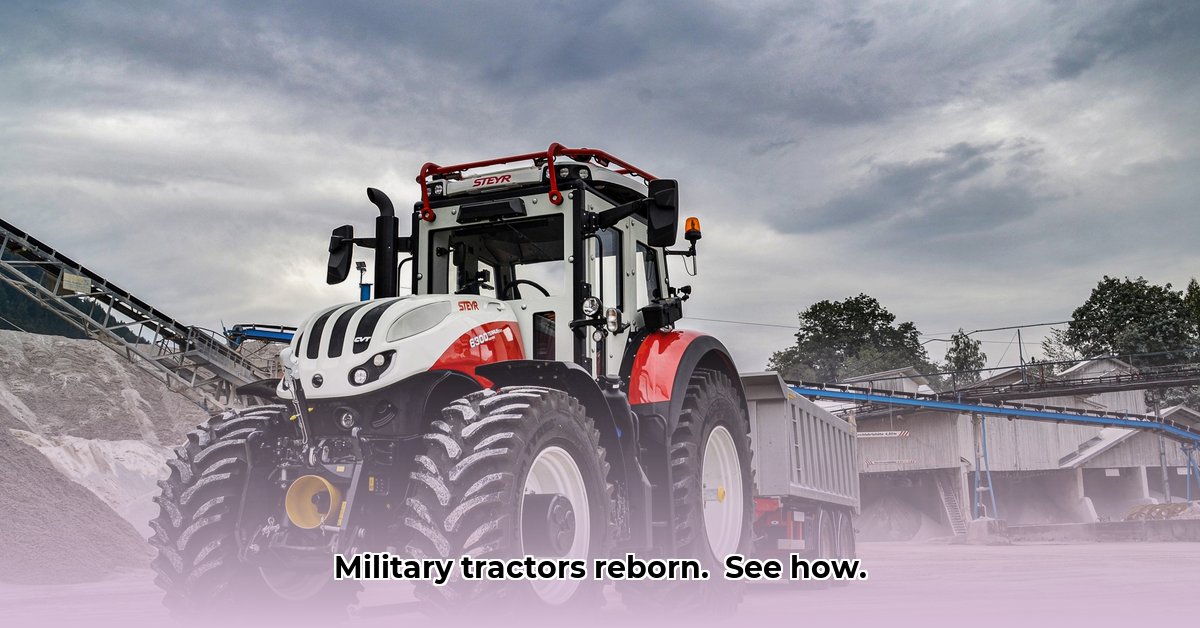
The remanufacturing of military tractors represents a significant niche market offering substantial opportunities for businesses capable of navigating the complexities of parts sourcing, stringent quality control, and continuous technological integration. This detailed analysis explores the market landscape, technical processes, challenges, and future trends shaping this specialized sector. For more information on military vehicle types, check out this resource.
Market Overview: A Landscape of Challenges and Opportunities
The military tractor remanufacturing market is a relatively opaque sector, dominated by key players such as Memphis Equipment and Oshkosh. Precise market sizing proves difficult due to the confidential nature of many defense contracts and the fluctuating nature of government surplus sales. This lack of transparency presents a significant challenge for long-term market forecasting and strategic planning. However, consistent demand driven by the need for cost-effective fleet extension and avoidance of lengthy procurement cycles sustains the industry. What percentage of military fleets currently utilize remanufactured vehicles? Further research is needed to quantify this crucial aspect of the market.
The Remanufacturing Process: A Multi-Stage Undertaking
Remanufacturing a military tractor is far more complex than simple repair; it's a comprehensive and meticulous process involving multiple distinct stages:
Complete Disassembly and Inspection: Every component is carefully removed and thoroughly inspected for wear, damage, or obsolescence. This detailed analysis forms the basis for subsequent repair and replacement decisions.
Component Evaluation and Parts Sourcing: This stage identifies the need for replacement or refurbishment. Sourcing replacement parts can be challenging, relying on original equipment manufacturers (OEMs), salvaged parts, or increasingly, 3D-printed alternatives. The selection of parts significantly impacts the final quality and performance of the remanufactured tractor.
Refurbishment and Repair: Skilled technicians meticulously repair or restore components to original specifications, often incorporating upgrades to enhance performance or longevity. This phase requires specialized knowledge and tools.
Reassembly and Rigorous Testing: Following component replacement and repair, the tractor undergoes careful reassembly. Subsequently, it undergoes comprehensive testing to ensure it meets stringent performance and safety standards, a crucial stage for operational readiness.
Quality Assurance and Certification: A final quality check verifies the adherence to specifications and certifies the remanufactured tractor's readiness for deployment.
Challenges and Opportunities: Navigating a Complex Market
The remanufacturing sector faces several key challenges:
- Parts Sourcing: Obtaining original or compatible replacement parts for older or specialized military tractors can be extremely difficult.
- Regulatory Compliance: Strict regulations surrounding military equipment, including export controls and environmental standards, add significant complexity.
- Technological Updates: Integrating modern technologies and maintaining compatibility with evolving military systems is essential but presents ongoing challenges.
Despite these challenges, opportunities abound:
- Sustainability: Remanufacturing offers a significantly more environmentally friendly alternative to new vehicle production, aligning with growing sustainability initiatives.
- Civilian Market Expansion: Adapted versions of these robust tractors could find applications in demanding civilian sectors such as agriculture or construction, broadening the market potential.
Competitive Landscape: Key Players and Strategies
The remanufacturing market features a few dominant players, most notably Memphis Equipment and Oshkosh. Their competitive strengths and weaknesses vary:
| Remanufacturer | Strengths | Weaknesses |
|---|---|---|
| Memphis Equipment | Extensive experience; robust parts network | Limited customization options; less technological innovation |
| Oshkosh | Technological innovation; robust R&D capabilities | Potentially higher costs; limited experience with older models |
Successful strategies for competitors involve:
- Short-term: Enhanced online marketing, refined inventory management, and strong customer service.
- Long-term: Strategic partnerships with parts suppliers, investment in advanced manufacturing techniques (such as 3D printing), and expansion into civilian markets.
Future Trends: Technological Advancements and Market Shifts
Future success hinges on adaptability to evolving technologies and market demands:
- Technological Integration: 3D printing, AI-driven predictive maintenance, and advanced materials will play increasingly crucial roles in improving efficiency and extending the lifespan of remanufactured tractors.
- Regulatory Changes: Continuous monitoring and adaptation to evolving environmental and export regulations are necessary to ensure compliance.
- Sustainability Focus: The growing emphasis on sustainable practices will drive demand for environmentally friendly remanufacturing, creating further opportunities.
Conclusion: Opportunities for Growth and Innovation
The remanufacturing of military tractors presents a unique market with significant potential for growth and innovation. Businesses that can adeptly navigate the challenges of parts sourcing, regulatory compliance, and technological integration, while capitalizing on the opportunities presented by sustainability and market diversification, are well-positioned for long-term success. The sector's future will be defined by technological advancements and a continued focus on meeting the evolving demands of both military and civilian applications.